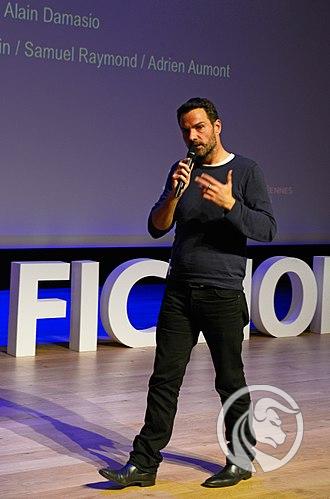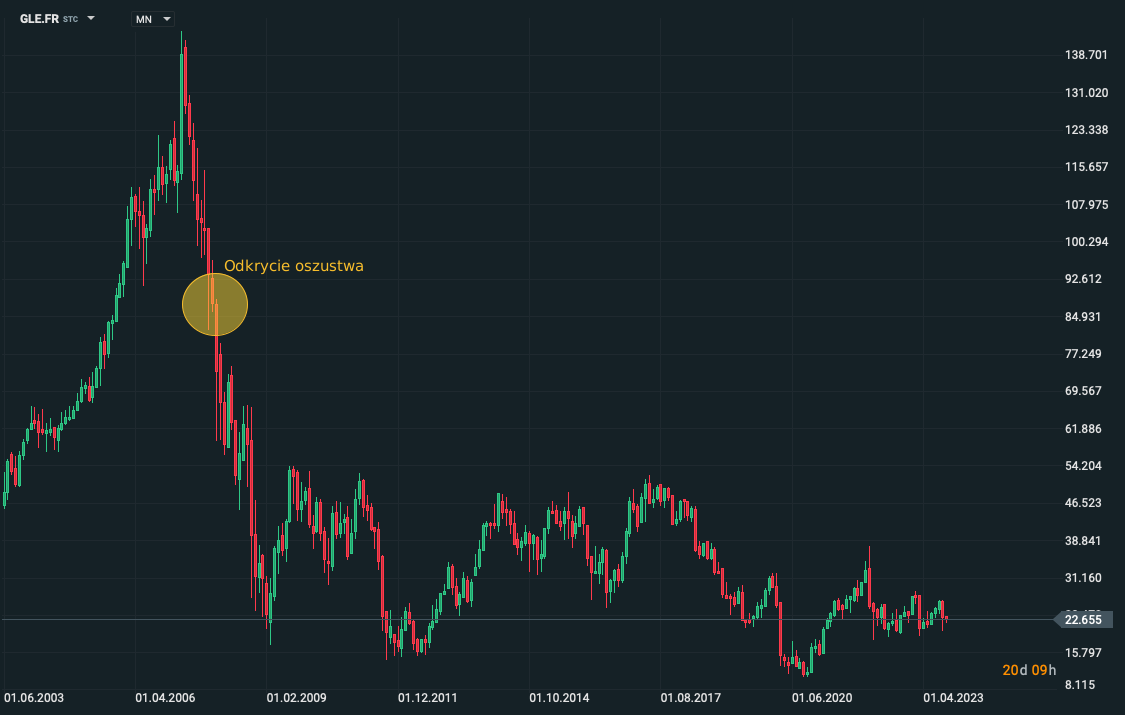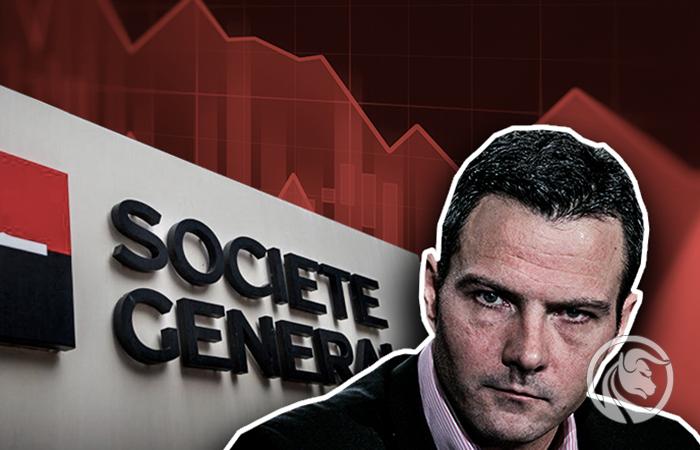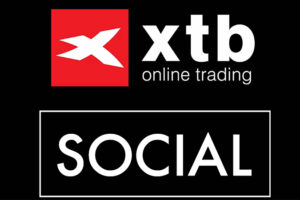Jerome Kerviel – financial terrorist or victim?
Not every trader has one "honor" be named financial terrorist. This is how our hero was described by Daniel Burton, who was the CEO of Societe Generale. Jerome kerviel is known in the world of finance and business as a former trader in a French bank - Société Générale - who was involved in one of the largest trading scandals in history. He was accused of carrying out a series of unauthorized transactions between 2006 and 2008. As a result of his actions, the company lost over EUR 4,9 billion. As a result of the investigation, it turned out that he had open positions with a nominal value of approximately €50 billion. How did this situation come about? Why didn't the bank's supervision work properly? You will learn about it in this article.
Who is Jerome Kerviel?

Jerome Kerviel in 2015. Source: wikipedia.org
Kerviel was born on January 11, 1977 and grew up in Pont L'Abby in Brittany, France. He comes from a working-class family, his mother was a hairdresser and his father was a blacksmith. Despite a difficult start, Jerome Kerviel began studying finance at the University of Nantes. He graduated in 1999 and continued his studies at the University of Lyon. He was also involved in sports, practicing judo for 8 years, where he obtained a green belt. He stopped training judo due to a knee injury. Apart from judo, he was interested in sailing.
In 2000, at the age of only 23, he started his career at Société Générale. At first, he worked in an office where he helped administer the bank's database. With technological development, Jerome began implementing computerized trading systems. His work was quickly noticed. Already in 2002, he became a trader's assistant. As an assistant, he dealt with risk analysis and hedging. After three years, Jerome Kerviel fulfilled his dreams and became a trader, where he made transactions on the derivatives market. His activities partly resembled tasks market maker. Jerome exploited price discrepancies between equity derivatives and the cash market.
As a junior trader, he dealt mainly with German companies. After a few months of work, he took a short position on Allianz shares. At first he lost on the transaction, but "helped" him an attack on the London Underground. The stock market reacted with declines and Jerome made a profit of €500 on the position. The superiors liked this. As a result, his risk exposure limit was increased from €2 million to €5 million. It was a great distinction for a junior trader. Promotion to the position of trader was a dream come true. Jerome himself mentioned that in 2006 he earned €20 million by taking a short position on DAX 30 index. According to him, the nominal value of the contract was to be “several billion euros”.
The promotion meant a significant pay increase. His salary as a trader was €50 per year. It was relatively small for such a position, but for him it was more than he expected. In addition, he could receive bonuses for the results generated. In the following years, earnings increased, in 000 the salary was already €2006 per year. In the same year, Kerviel received a bonus of €60. The earnings were small compared to the best traders. So he wasn't a star in his bank. Jerome himself hoped to receive a €2007 bonus in 600, but he only got half of it. And we will come back to this.
How did banks protect themselves against risk?
To explain what happened in the years 2006-2008, it is necessary to understand the principles of market risk management in an investment bank. We already know that Jerome Kerviel was a derivatives trader. It is worth explaining what derivatives are.
Derivatives are financial instruments that enable the use of financial leverage. Thanks to futures, options and swap contracts, a bank trader could take a position many times larger than the available investment budget.
The bank should always control investment risk. Control was performed both using transaction limits and risk exposure analysis (e.g. Value-at-Risk). Well-conducted control and monitoring of transactions means that the bank knows how much it can lose in the event of an unfavorable scenario. The internal risk management unit plays a key role. Thanks to it, the bank controls the risk exposure of both individual asset classes and the activities of specific traders. If the exposure to an instrument is, according to the audit, too high, the trader must reduce the position. Without an efficient risk control department, the bank is blind. Weak supervision means traders may take too much risk. Why would a trader take too much risk? The reason is simple – bonusy. The higher the profit, the greater the chance of receiving a bonus. Greater risk means a chance for greater profits.
How did Jerome Kerviel defraud his own bank?
At the beginning of his career at Société Générale, Kerviel worked in the back office. Thanks to this, he knew the nuances of risk management. He knew how the audit department examined market exposure. Jerome Kerviel knew that unauthorized transactions were possible. This was possible thanks to large security gaps. In line with Delta One's assumptions, entering a short-term trade that opened and closed a position on the same day.
Armed with such knowledge, our hero held the position from 2006 to 2008 “paper” transactions that were intended to close actually open positions. Another problem was that some transactions were concluded on the over-the-counter market (OTC). This trader activity resulted in some trades not appearing in the trade log. After his arrest, it turned out that he hacked into the system and entered false transactions. This was supposed to keep it within the limits imposed by the risk department.
However, it is worth asking yourself: why was he able to carry out such scams for almost two years? After all, his logins to the system were visible. Some people believe that the bank knew about his practices, but as long as he was making money, no one touched him. When losses started to appear, the bank immediately “discovered” his deception. Well, we'll probably never know the truth.
In an interview for Spiegel, Jerome Kerviel mentioned that as long as he was bringing profits to the bank, managers regularly raised his risk limits. Between 2006 and 2008, the total increase in the limit was 1700%. That is, the managers allowed him to take positions 17 times larger than at the beginning of his trading adventure.
In October 2007, Eurex, the German derivatives exchange, reported that one of Societe Generale's traders manipulated the German stock market. It turned out that someone had taken a position with a nominal value of €30 billion on DAX. That someone was Kerviel, who was betting on the index falling. After the price dropped, the trader closed the position with a profit, which helped stabilize the market. Probably no one at the bank had any objections, since Jerome had not been fired even then.
The fact is that Jerome had a great appetite for risk. According to later research, the trader had open positions worth €50 billion. It was more than the capitalization of the French bank. The transactions brought high income, which translated into bonuses for profits. In 2007, the bank earned €1,4 billion on Kerviel's transactions. The trader, in turn, was waiting for the bonus he was entitled to.
This exposure was shocking. After all, the trader worked in the Delta-One department. It was a cell that was ultimately intended to carry out only safe transactions with a small but certain profit. Theoretically, a single trader could not hold more than €125 million in one position. Moreover, the transactions were to be hedged.
After some time, Kerviel began to fear that his practices would be discovered. To this end, he began to reduce risk. However, in January 2008, a risk officer discovered some discrepancies in Jerome's transactions. The trader's explanations were so vague that the supervision decided to conduct a thorough audit. Senior managers and financial supervision were notified. French bank managers were developing a crisis exit strategy throughout the weekend. The exposure to derivatives was so large that it was no longer difficult to manage. Actions were needed to close the position. This couldn't happen without losses. Frantic risk reduction began, leading to large losses for the bank.
Huge positions were taken in futures contracts on three European share indices: DAX, Euro Stoxx 50 and CAC 40. After complete assessment losses were calculated at EUR 4,9 billion. Such "too bad" it shook the condition of this French giant. Kerviel explained that his superiors knew about his actions, but did not react because his transactions brought profits.
Ultimately, Kerviel was fired, and the bank additionally demanded that he pay back €4,9 billion. How journalists calculated it, if Jerome worked outside the financial industry, he would need 177. years to make up for the bank's losses. Societe's action was therefore a typical action “to the public”.
Kerviel himself mentioned in an interview for Spiegel:
“I didn't make even a penny [on the trades]. I have not enriched myself personally and I have not committed any crime. I just wanted to be a good employee who generates as much profit for the employer as possible.”
Kerviel's legal path
After discovering illegal activities by its trader, Societe Generale reported the matter to law enforcement authorities. He was charged with forgery, unauthorized use of company equipment and breach of trust. In 2010, he was sentenced by the court to 3 years in prison and 2 years of probation. In addition, it was obliged to pay €4,9 billion in compensation to Societe Generale. Kerviel appealed against the fine and suggested he wasn't doing it for economic gain. He suggested that management couldn't have been unaware for so many years. So they weren't “occasional neglect”, Of “management choices”. In 2012, the court upheld the verdict, but decided a few years later on reducing the financial penalty to €1 million. Kerviel was released from prison in 2014 after 5 months of serving his sentence.
In 2016, Jerome Kerviel won a case for unfair dismissal. He was awarded €450 in compensation. However, the joy did not last long. After only two years, the appellate court decided not to pay compensation. The justification emphasized that although Jerome's intention was not to generate losses for the bank, the trader's dismissal was legal. For this reason, there is no basis for paying compensation.
Did Kerviel act alone?
Some people find it hard to believe that a single trader could open such large positions on his own. They suggest that Kerviel did not act independently, but with the consent of senior management. However, there is no evidence in the form of e-mails, text messages or other means of communication that would confirm this thesis. So these are just guesses.
Others, in turn, argue that managers did not tell them to open specific high-value positions. All they were doing, most likely, was putting pressure on themselves to make as much profit as possible. Due to the fact that Jerome Kerviel was most likely an ambitious person and wanted to be the best in the team, he decided to increase the risk to generate above-average profits. Even if this is true, it appears that the risk management department did not fulfill its role. After all, there should be systems in place that regularly check risk exposure. It was playing with fire. Paradoxically, Societe Generale was lucky that the scandal occurred in early 2008. Lack of risk control could "put" this bank while collapse of Lehman Brothers.
Summation
The story of Jerome Kerviel can be viewed from two perspectives. On the one hand, he was an irresponsible trader who made trades and forgeries while working at the bank. Regardless of his motives, these were his conscious decisions. If he was forced to act unethically, he could always refuse. He did not do it. On the other hand, we can see how badly banks were managed a dozen or so years ago. After all, even if Jerome acted in concert with others in the Delta One department, internal control should have discovered such practices very quickly. For some reason this didn't work out for them.
Societe Generale survived the crash of 2008-2009 and the problems of the PIGS countries. However, investors can only dream of the bank's price returning to the levels seen in the Kerviel scandal. The hero himself takes part in conferences devoted to financial fraud. Previously, after being dismissed from Societe Generale, he worked for the French consulting company LCA.

Societe Generale chart, MN interval. Source: xNUMX XTB.
Jerome Kerviel's story shows how important risk control is. Financial leverage it is only a blessing when you are right or when you can manage the risks. When you start making mistakes and the risk gets out of control, the losses multiply. This was the case with this French trader. For some time it generated high profits, but it ended with a loss exceeding over €4 billion. He is certainly not a financial terrorist, but one of the worst traders in history. Due to his actions, Societe Generale found itself in financial difficulties. You could say that's it "The Nick Leeson of Our Times" – if you don't know his story, be sure to catch up -> "Nick Leeson - the broker who brought down Barings Bank".






















![Forex Club – Tax 9 – Settle tax on a foreign broker [Download the Application] Forex Club - Tax 9](https://forexclub.pl/wp-content/uploads/2024/02/Forex-Club-Podatek-9-184x120.jpg?v=1709046278)
![Trading View platform – solutions tailored to the needs of traders [Review] trading view review](https://forexclub.pl/wp-content/uploads/2024/03/trading-view-recenzja-184x120.jpg?v=1709558918)
![How to connect your FP Markets account to the Trading View platform [Guide] fp markets trading view](https://forexclub.pl/wp-content/uploads/2024/02/fp-markets-trading-view-184x120.jpg?v=1708677291)
![How to invest in ChatGPT and AI? Stocks and ETFs [Guide] how to invest in chatgpt and artificial intelligence](https://forexclub.pl/wp-content/uploads/2023/02/jak-inwestowac-w-chatgpt-i-sztuczna-inteligencje-184x120.jpg?v=1676364263)




![Izabela Górecka – “Success on the market depends not only on knowledge, but also on emotional stability” [Interview] Izabela Górecka - interview](https://forexclub.pl/wp-content/uploads/2024/04/Izabela-Gorecka-wywiad-184x120.jpg?v=1713870578)
![WeWork – the anatomy of the collapse of a company valued at $47 billion [WeWork, part II] wework bankruptcy story](https://forexclub.pl/wp-content/uploads/2024/04/wework-bankructwo-historia-184x120.jpg?v=1711729561)
![Adam Neumann – the man who screwed up Softbank [WeWork, part AND] adam neumann wework](https://forexclub.pl/wp-content/uploads/2024/04/adam-neumann-wework-184x120.jpg?v=1711728724)




![The most common mistakes of a beginner trader - Mr Yogi [VIDEO] Scalping - The most common mistakes of a beginner trader - VIDEO](https://forexclub.pl/wp-content/uploads/2024/03/Scalping-Najczestsze-bledy-poczatkujacego-tradera-VIDEO-184x120.jpg?v=1711601376)
![Learning patience: No position is also a position - Mr Yogi [VIDEO] Scalping - Learning patience - No position is also a position - VIDEO](https://forexclub.pl/wp-content/uploads/2024/03/Scalping-Nauka-cierpliwosci-Brak-pozycji-to-tez-pozycja-VIDEO-184x120.jpg?v=1710999249)
![When to exit a position and how to minimize losses - Mr Yogi [VIDEO] Scalping - When to exit a position and how to minimize losses - VIDEO](https://forexclub.pl/wp-content/uploads/2024/03/Scalping-Kiedy-wyjsc-z-pozycji-i-jak-minimalizowac-straty-VIDEO-184x120.jpg?v=1710336731)




![Izabela Górecka – “Success on the market depends not only on knowledge, but also on emotional stability” [Interview] Izabela Górecka - interview](https://forexclub.pl/wp-content/uploads/2024/04/Izabela-Gorecka-wywiad-300x200.jpg?v=1713870578)
![Trading View platform – solutions tailored to the needs of traders [Review] trading view review](https://forexclub.pl/wp-content/uploads/2024/03/trading-view-recenzja-300x200.jpg?v=1709558918)













Leave a Response